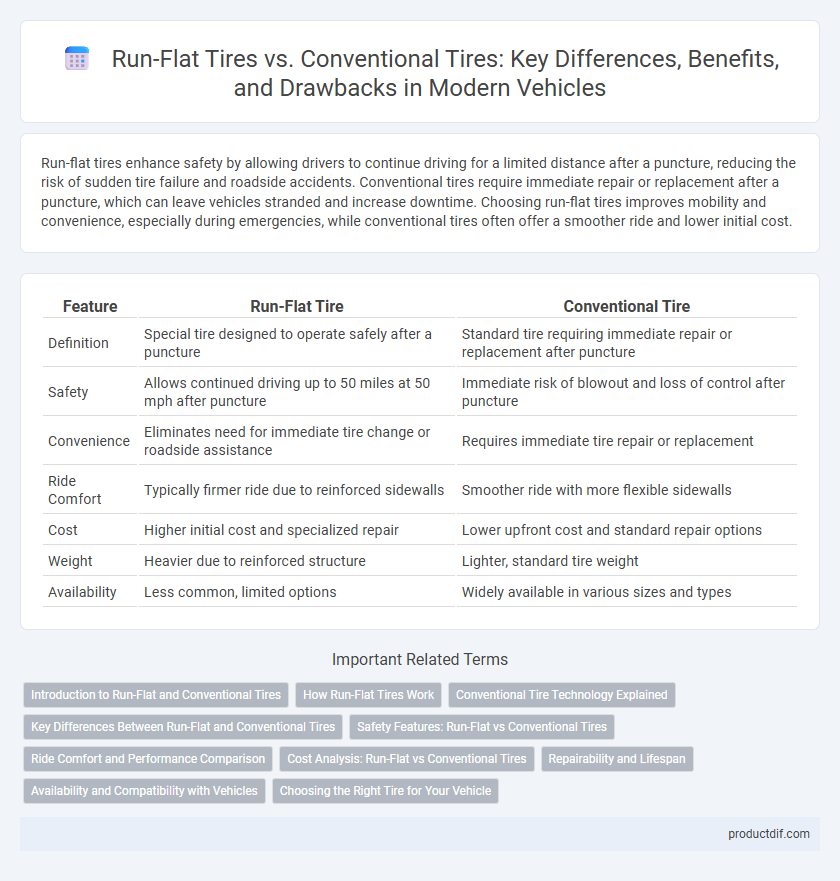Run-flat tires enhance safety by allowing drivers to continue driving for a limited distance after a puncture, reducing the risk of sudden tire failure and roadside accidents. Conventional tires require immediate repair or replacement after a puncture, which can leave vehicles stranded and increase downtime. Choosing run-flat tires improves mobility and convenience, especially during emergencies, while conventional tires often offer a smoother ride and lower initial cost.
Table of Comparison
| Feature | Run-Flat Tire | Conventional Tire |
|---|---|---|
| Definition | Special tire designed to operate safely after a puncture | Standard tire requiring immediate repair or replacement after puncture |
| Safety | Allows continued driving up to 50 miles at 50 mph after puncture | Immediate risk of blowout and loss of control after puncture |
| Convenience | Eliminates need for immediate tire change or roadside assistance | Requires immediate tire repair or replacement |
| Ride Comfort | Typically firmer ride due to reinforced sidewalls | Smoother ride with more flexible sidewalls |
| Cost | Higher initial cost and specialized repair | Lower upfront cost and standard repair options |
| Weight | Heavier due to reinforced structure | Lighter, standard tire weight |
| Availability | Less common, limited options | Widely available in various sizes and types |
Introduction to Run-Flat and Conventional Tires
Run-flat tires feature reinforced sidewalls that support the vehicle's weight even after a complete loss of air pressure, enabling continued driving for up to 50 miles at reduced speeds. Conventional tires rely on maintaining proper air pressure for structural integrity and require immediate repair or replacement after a puncture. The advanced design of run-flat tires provides enhanced safety and convenience, while conventional tires generally offer a wider range of options and better ride comfort.
How Run-Flat Tires Work
Run-flat tires feature reinforced sidewalls that support the vehicle's weight even when air pressure is lost, allowing drivers to continue driving safely for limited distances at reduced speeds. These tires maintain structural integrity by preventing the tire from collapsing, which reduces the risk of sudden blowouts and enhances overall safety. Run-flat technology enables vehicles to avoid immediate roadside tire changes, providing convenience and increased control during emergencies.
Conventional Tire Technology Explained
Conventional tire technology relies on flexible sidewalls that support the vehicle's weight and maintain stability during driving. These tires require immediate repair or replacement after a puncture, as they lack the reinforced structure of run-flat tires. Traditional tires provide enhanced comfort and a wider selection of tread patterns, contributing to better fuel efficiency and overall ride quality.
Key Differences Between Run-Flat and Conventional Tires
Run-flat tires feature reinforced sidewalls that allow a vehicle to continue driving for up to 50 miles at reduced speeds after a puncture, enhancing safety and convenience. Conventional tires require immediate repair or replacement following a puncture, as they cannot support the vehicle's weight once air pressure is lost. Weight differences also impact fuel efficiency, with run-flat tires generally heavier, potentially affecting ride comfort compared to conventional tires.
Safety Features: Run-Flat vs Conventional Tires
Run-flat tires enhance vehicle safety by maintaining structural integrity and allowing continued driving for up to 50 miles after a puncture, reducing the risk of sudden blowouts and enabling drivers to reach a repair shop safely. Conventional tires lack this capability, often resulting in sudden air loss that can cause loss of control and increased accident risk. The reinforced sidewalls of run-flat tires provide better stability and prevent tire detachment from the rim during deflation, significantly improving safety compared to standard tires.
Ride Comfort and Performance Comparison
Run-flat tires maintain vehicle mobility after air loss, enhancing safety but often sacrificing ride comfort compared to conventional tires. Conventional tires typically provide a smoother, quieter ride due to more flexible sidewalls and better shock absorption. Performance-wise, run-flat tires offer stable handling during punctures, while conventional tires excel in overall driving comfort and lower rolling resistance, improving fuel efficiency.
Cost Analysis: Run-Flat vs Conventional Tires
Run-flat tires generally come with a higher upfront cost, often ranging from 20% to 50% more than conventional tires, reflecting their advanced technology and reinforced sidewalls. While run-flats may reduce expenses related to roadside assistance and towing, their repairability is limited, often requiring full replacement after punctures, which can increase long-term maintenance costs. Conventional tires tend to offer greater affordability and easier repair options, making them more cost-effective for drivers prioritizing lower initial investment and tire service flexibility.
Repairability and Lifespan
Run-flat tires offer limited repairability due to reinforced sidewalls designed to support the vehicle temporarily after a puncture, often necessitating replacement rather than repair. Conventional tires generally allow for easier puncture repairs with patches or plugs, extending their usability and lifespan. However, run-flat tires typically have a shorter overall lifespan because their stiffer construction can lead to faster wear and a reduced ability to absorb road impacts effectively.
Availability and Compatibility with Vehicles
Run-flat tires are increasingly available on new vehicles, especially luxury and performance models, but they remain less common than conventional tires, which are widely accessible across all vehicle types. Compatibility with run-flat tires typically requires specific wheel and suspension designs to support their reinforced sidewalls, limiting their use to vehicles equipped or certified for them. Conventional tires offer broader compatibility, fitting a wider range of vehicles without the need for specialized components or systems.
Choosing the Right Tire for Your Vehicle
Run-flat tires offer enhanced safety and convenience by allowing continued driving after a puncture, making them ideal for drivers prioritizing mobility and quick roadside resolution. Conventional tires typically provide better ride comfort, lower cost, and a wider selection, suiting drivers who prefer traditional performance and budget-friendly options. Assess your vehicle type, driving habits, and emergency preparedness to determine whether run-flat or conventional tires best match your needs and ensure optimal performance.
Run-Flat Tire vs Conventional Tire Infographic

 productdif.com
productdif.com